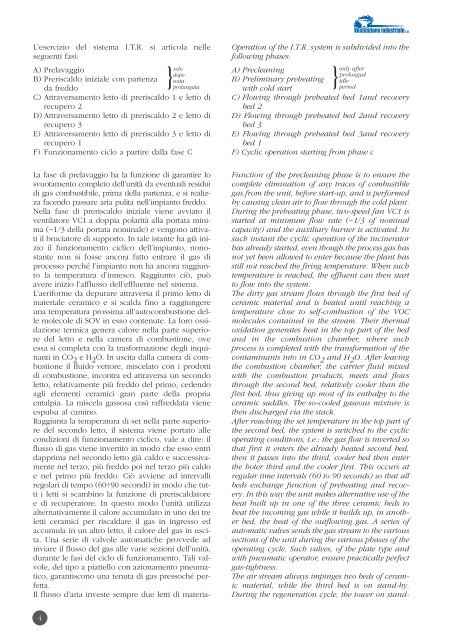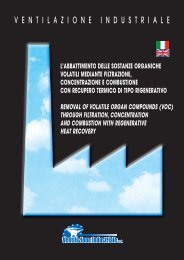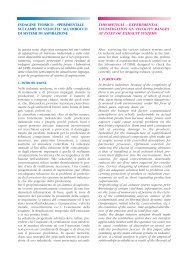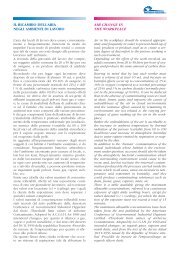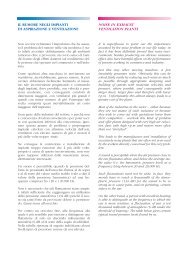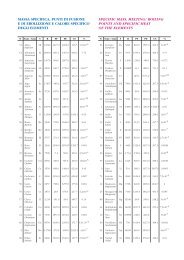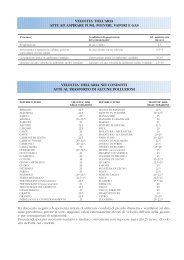impianti di combustione tipo rigenerativi regenerative combustion ...
impianti di combustione tipo rigenerativi regenerative combustion ...
impianti di combustione tipo rigenerativi regenerative combustion ...
Create successful ePaper yourself
Turn your PDF publications into a flip-book with our unique Google optimized e-Paper software.
L’esercizio del sistema I.T.R. si articola nelle<br />
seguenti fasi:<br />
A) Prelavaggio<br />
B) Preriscaldo iniziale con partenza<br />
da freddo<br />
}solo<br />
dopo<br />
sosta<br />
prolungata<br />
C) Attraversamento letto <strong>di</strong> preriscaldo 1 e letto <strong>di</strong><br />
recupero 2<br />
D) Attraversamento letto <strong>di</strong> preriscaldo 2 e letto <strong>di</strong><br />
recupero 3<br />
E) Attraversamento letto <strong>di</strong> preriscaldo 3 e letto <strong>di</strong><br />
recupero 1<br />
F) Funzionamento ciclo a partire dalla fase C<br />
Operation of the I.T.R. system is sub<strong>di</strong>vided into the<br />
following phases:<br />
A) Precleaning }only after<br />
prolonged<br />
B) Preliminary preheating idle<br />
with cold start<br />
period<br />
C) Flowing through preheated bed 1and recovery<br />
bed 2<br />
D) Flowing through preheated bed 2and recovery<br />
bed 3<br />
E) Flowing through preheated bed 3and recovery<br />
bed 1<br />
F) Cyclic operation starting from phase c<br />
La fase <strong>di</strong> prelavaggio ha la funzione <strong>di</strong> garantire lo<br />
svuotamento completo dell’unità da eventuali residui<br />
<strong>di</strong> gas combustibile, prima della partenza, e si realizza<br />
facendo passare aria pulita nell’impianto freddo.<br />
Nella fase <strong>di</strong> preriscaldo iniziale viene avviato il<br />
ventilatore VC1 a doppia polarità alla portata minima<br />
(~1/3 della portata nominale) e vengono attivati<br />
il bruciatore <strong>di</strong> supporto. In tale istante ha già inizio<br />
il funzionamento ciclico dell’impianto, nonostante<br />
non si fosse ancora fatto entrare il gas <strong>di</strong><br />
processo perché l’impianto non ha ancora raggiunto<br />
la temperatura d’innesco. Raggiunto ciò, può<br />
avere inizio l’afflusso dell’effluente nel sistema.<br />
L’aeriforme da depurare attraversa il primo letto <strong>di</strong><br />
materiale ceramico e si scalda fino a raggiungere<br />
una temperatura prossima all’auto<strong><strong>combustion</strong>e</strong> delle<br />
molecole <strong>di</strong> SOV in esso contenute. La loro ossidazione<br />
termica genera calore nella parte superiore<br />
del letto e nella camera <strong>di</strong> <strong><strong>combustion</strong>e</strong>, ove<br />
essa si completa con la trasformazione degli inquinanti<br />
in CO 2 e H 2 O. In uscita dalla camera <strong>di</strong> <strong><strong>combustion</strong>e</strong><br />
il fluido vettore, miscelato con i prodotti<br />
<strong>di</strong> <strong><strong>combustion</strong>e</strong>, incontra ed attraversa un secondo<br />
letto, relativamente più freddo del primo, cedendo<br />
agli elementi ceramici gran parte della propria<br />
entalpia. La miscela gassosa così raffreddata viene<br />
espulsa al camino.<br />
Raggiunta la temperatura <strong>di</strong> set nella parte superiore<br />
del secondo letto, il sistema viene portato alle<br />
con<strong>di</strong>zioni <strong>di</strong> funzionamento ciclico, vale a <strong>di</strong>re: il<br />
flusso <strong>di</strong> gas viene invertito in modo che esso entri<br />
dapprima nel secondo letto già caldo e successivamente<br />
nel terzo, più freddo poi nel terzo più caldo<br />
e nel primo più freddo. Ciò avviene ad intervalli<br />
regolari <strong>di</strong> tempo (60÷90 secon<strong>di</strong>) in modo che tutti<br />
i letti si scambino la funzione <strong>di</strong> preriscaldatore<br />
e <strong>di</strong> recuperatore. In questo modo l’unità utilizza<br />
alternativamente il calore accumulato in uno dei tre<br />
letti ceramici per riscaldare il gas in ingresso ed<br />
accumula in un altro letto, il calore del gas in uscita.<br />
Una serie <strong>di</strong> valvole automatiche provvede ad<br />
inviare il flusso del gas alle varie sezioni dell’unità,<br />
durante le fasi del ciclo <strong>di</strong> funzionamento. Tali valvole,<br />
del <strong>tipo</strong> a piattello con azionamento pneumatico,<br />
garantiscono una tenuta <strong>di</strong> gas pressoché perfetta.<br />
Il flusso d’aria investe sempre due letti <strong>di</strong> materia-<br />
Function of the precleaning phase is to ensure the<br />
complete elimination of any traces of combustible<br />
gas from the unit, before start-up, and is performed<br />
by causing clean air to flow through the cold plant.<br />
During the preheating phase, two-speed fan VC1 is<br />
started at minimum flow rate (~1/3 of nominal<br />
capacity) and the auxiliary burner is activated. In<br />
such instant the cyclic operation of the incinerator<br />
has already started, even though the process gas has<br />
not yet been allowed to enter because the plant has<br />
still not reached the firing temperature. When such<br />
temperature is reached, the effluent can then start<br />
to flow into the system.<br />
The <strong>di</strong>rty gas stream flows through the first bed of<br />
ceramic material and is heated until reaching a<br />
temperature close to self-<strong>combustion</strong> of the VOC<br />
molecules contained in the stream. Their thermal<br />
oxidation generates heat in the top part of the bed<br />
and in the <strong>combustion</strong> chamber, where such<br />
process is completed with the transformation of the<br />
contaminants into in CO 2 and H 2 O. After leaving<br />
the <strong>combustion</strong> chamber, the carrier fluid mixed<br />
with the <strong>combustion</strong> products, meets and flows<br />
through the second bed, relatively cooler than the<br />
first bed, thus giving up most of its enthalpy to the<br />
ceramic saddles. The so-cooled gaseous mixture is<br />
then <strong>di</strong>scharged via the stack.<br />
After reaching the set temperature in the top part of<br />
the second bed, the system is switched to the cyclic<br />
operating con<strong>di</strong>tions, i.e.: the gas flow is inverted so<br />
that first it enters the already heated second bed,<br />
then it passes into the third, cooler bed then enter<br />
the hoter third and the cooler first. This occurs at<br />
regular time intervals (60 to 90 seconds) so that all<br />
beds exchange function of preheating and recovery.<br />
In this way the unit makes alternative use of the<br />
heat built up in one of the three ceramic beds to<br />
heat the incoming gas while it builds up, in another<br />
bed, the heat of the outflowing gas. A series of<br />
automatic valves sends the gas stream to the various<br />
sections of the unit during the various phases of the<br />
operating cycle. Such valves, of the plate type and<br />
with pneumatic operator, ensure practically perfect<br />
gas-tightness.<br />
The air stream always impinges two beds of ceramic<br />
material, while the third bed is on stand-by.<br />
During the regeneration cycle, the tower on stand-<br />
4


